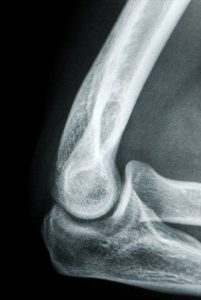 The human elbow is an intricate part of the body. While it is essentially a hinge joint and looks fairly straightforward – the elbow is made up of a complicated series of bones, joints, and ligaments. Within the elbow the radius and ulna must rotate and slide with the humerus to bend or straighten the arm. These movements are possible with the help of ligaments and there are two main ligaments that are important in order to achieve optimal elbow maneuverability: the lateral collateral ligament and the ulnar collateral ligament.
The human elbow is an intricate part of the body. While it is essentially a hinge joint and looks fairly straightforward – the elbow is made up of a complicated series of bones, joints, and ligaments. Within the elbow the radius and ulna must rotate and slide with the humerus to bend or straighten the arm. These movements are possible with the help of ligaments and there are two main ligaments that are important in order to achieve optimal elbow maneuverability: the lateral collateral ligament and the ulnar collateral ligament.
Both ligaments work together to keep the humerus connected to the ulna and to keep the ulna in place. Elbow stability depends on these two ligaments and when one is injured, it seriously affects how the elbow functions. Often, the ulnar collateral ligament is hurt through overuse or repetitive use. Not surprisingly, athletes who often depend on throwing motions are most likely to report ulnar collateral ligament injuries. This especially applies to baseball pitchers, quarterbacks in football, and softball players in the outfield. There are three phases to ulnar collateral ligament injuries and being aware of the stages can help to prevent further damage from occurring.
3 Phases to Ulnar Collateral Ligament Injuries
Phase 1: Microtearing
Microtearing is the first phase to a full blown ulnar collateral ligament injury. If it can be prevented then the injury has a better chance of being prevented. The small tears through the ligament occur when the force that the tissues are handling is heaving than the strength of the ligament. When the ligament starts to tear, it is not extremely noticeable. Often it takes months or years of repetitively hard throwing motions to begin the microtearing process.
Phase 2: Degeneration
Degeneration occurs after microtearing when the build-up of minute tears starts to wear away at the ulnar collateral ligament and leaves lasting damage that the body cannot keep up with repairing. When degeneration sets in, pain may start to occur in the elbow and swelling is often seen from the outside. If ulnar collateral ligament injuries are detected in this phase, the healing process can remain nonsurgical. Often, even when ulnar collateral ligament injuries have reached the degenerative stage, rest and modification of activity can stop the injury from worsening and allow the body a chance to start healing.
Phase 3: Rupturing
When an ulnar collateral ligament ruptures, it is accompanied by a loud pop and immediate pain. When an ulnar collateral ligament ruptures, the elbow will lose most of its stability. Sometimes a rupture can occur from just one powerful ligament tearing throw by an athlete; however, more often, the ligament will rupture after years of micro tears and degeneration has already weakened the ligament. When a rupture occurs, surgery is the main option for recovery and a board certified orthopedic surgeon can tell if an ulnar collateral ligament rupture will require repair or reconstruction.
Athletes who often use their arms to pitch, throw, or launch repetitively should be aware of the three phases that lead to ulnar collateral ligament injuries and seek qualified medical attention if they start to feel any of the following symptoms:
- Pain throughout the inside (side closest to your body) of the elbow
- Any popping sounds or grinding noises
- Swollen areas or bruising along the inside of the elbow
A simple MRI can detect any potential ligament injuries. If ulnar collateral ligament injuries are detected an orthopedic physician can help to set up a treatment plan. However, if the damage is too far along then surgery may be the only option.
If you are feeling any significant pain in either of your elbows, regardless of if you are an athlete or not, visit Dr. Stacie Grossfeld of Orthopaedic Specialists, PLLC in Louisville, KY. With the help of Dr. Grossfeld, you can prevent further damage to your ligaments, joints, and bones while starting a treatment plan to fix any existing damage. Contact Dr. Grossfeld here or by calling 502-212-2663 today!

Recent Comments